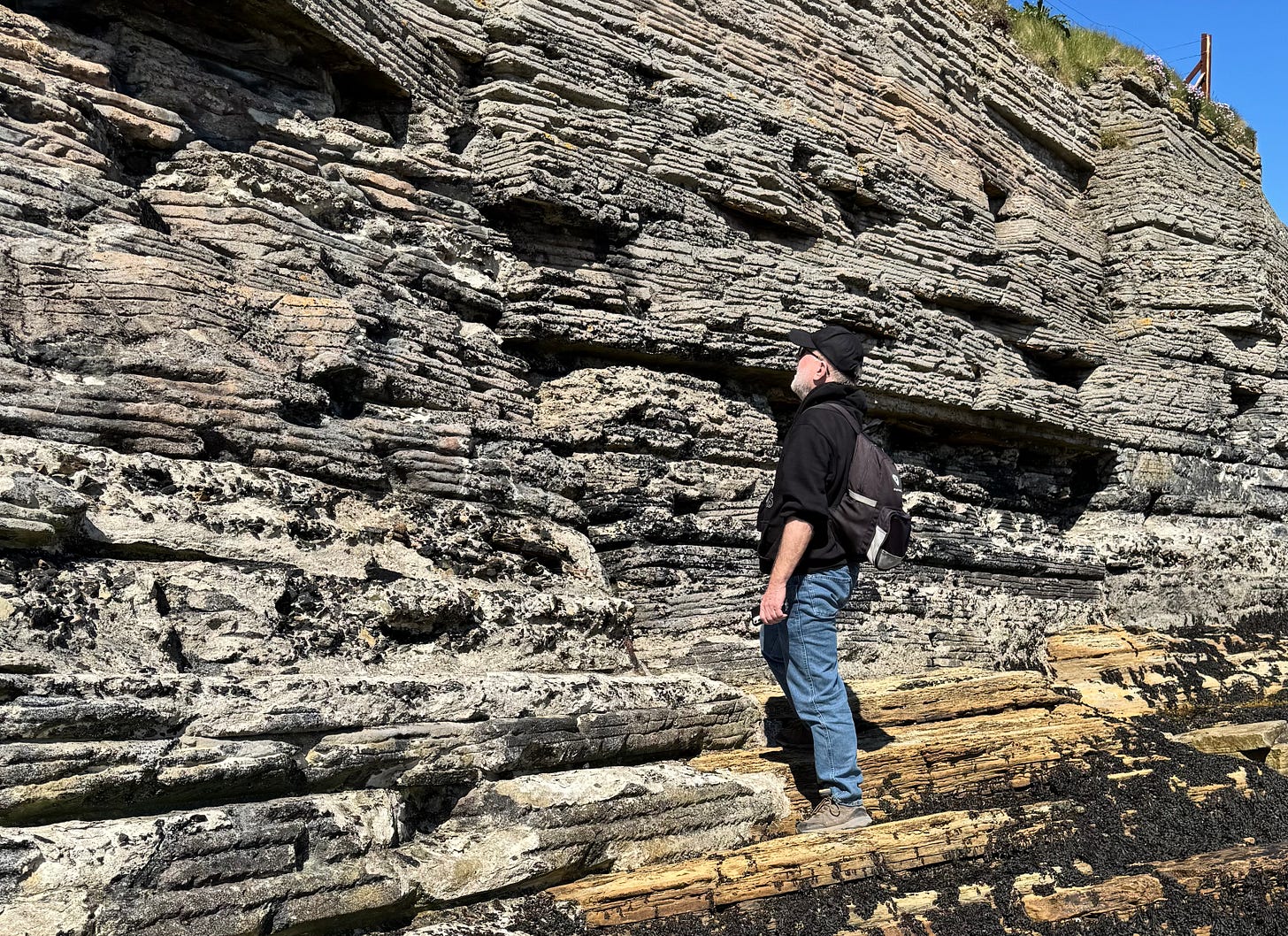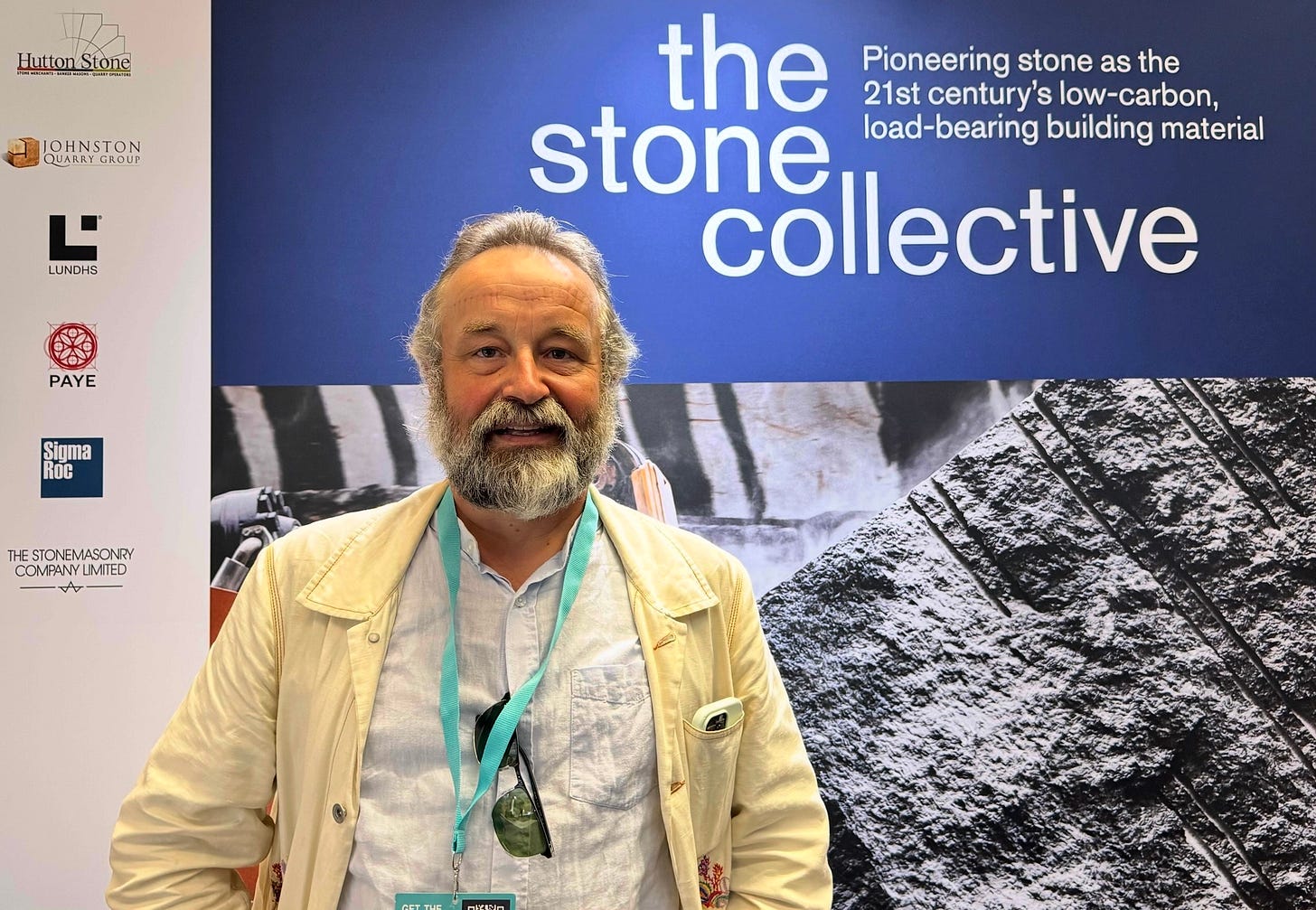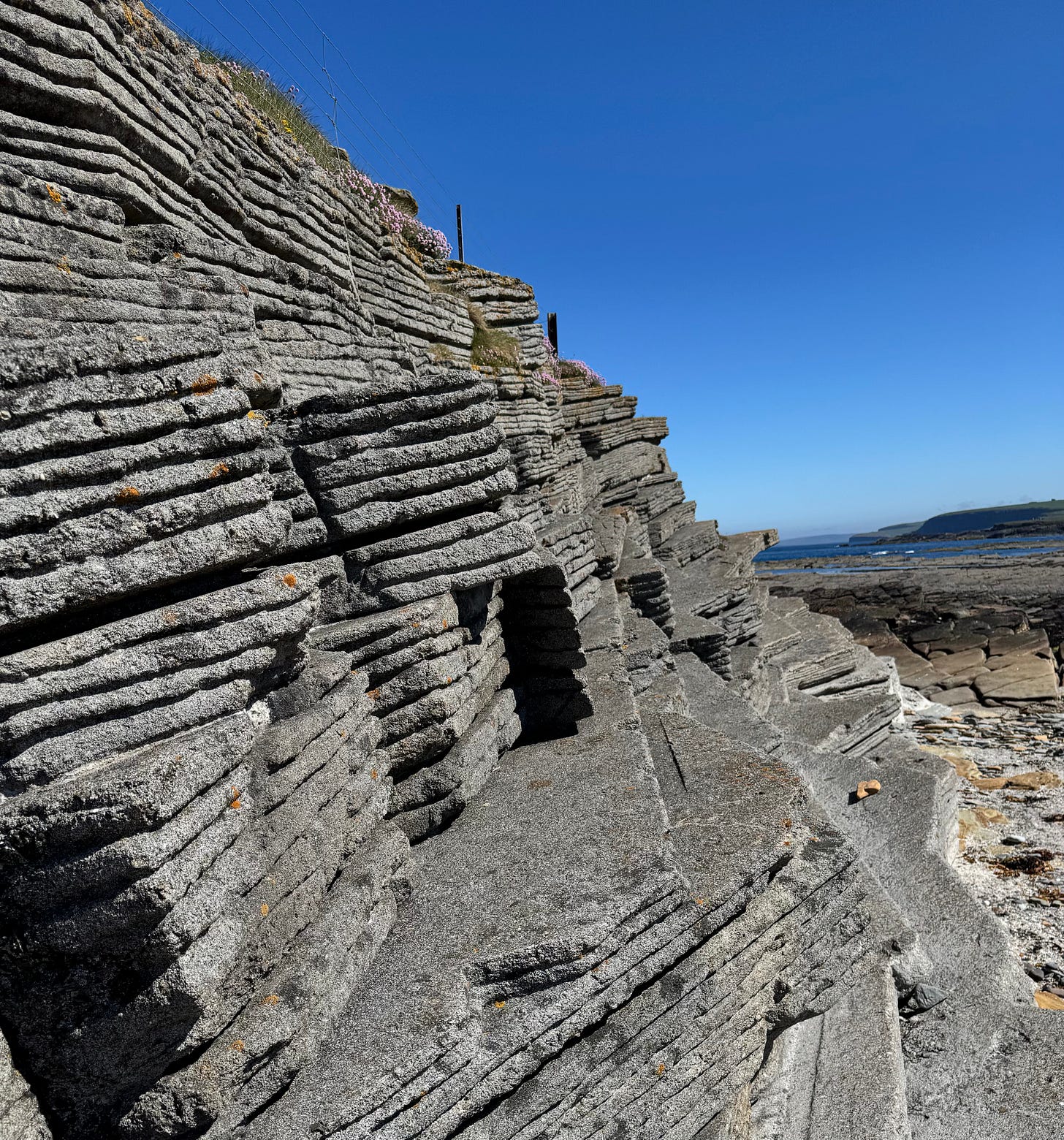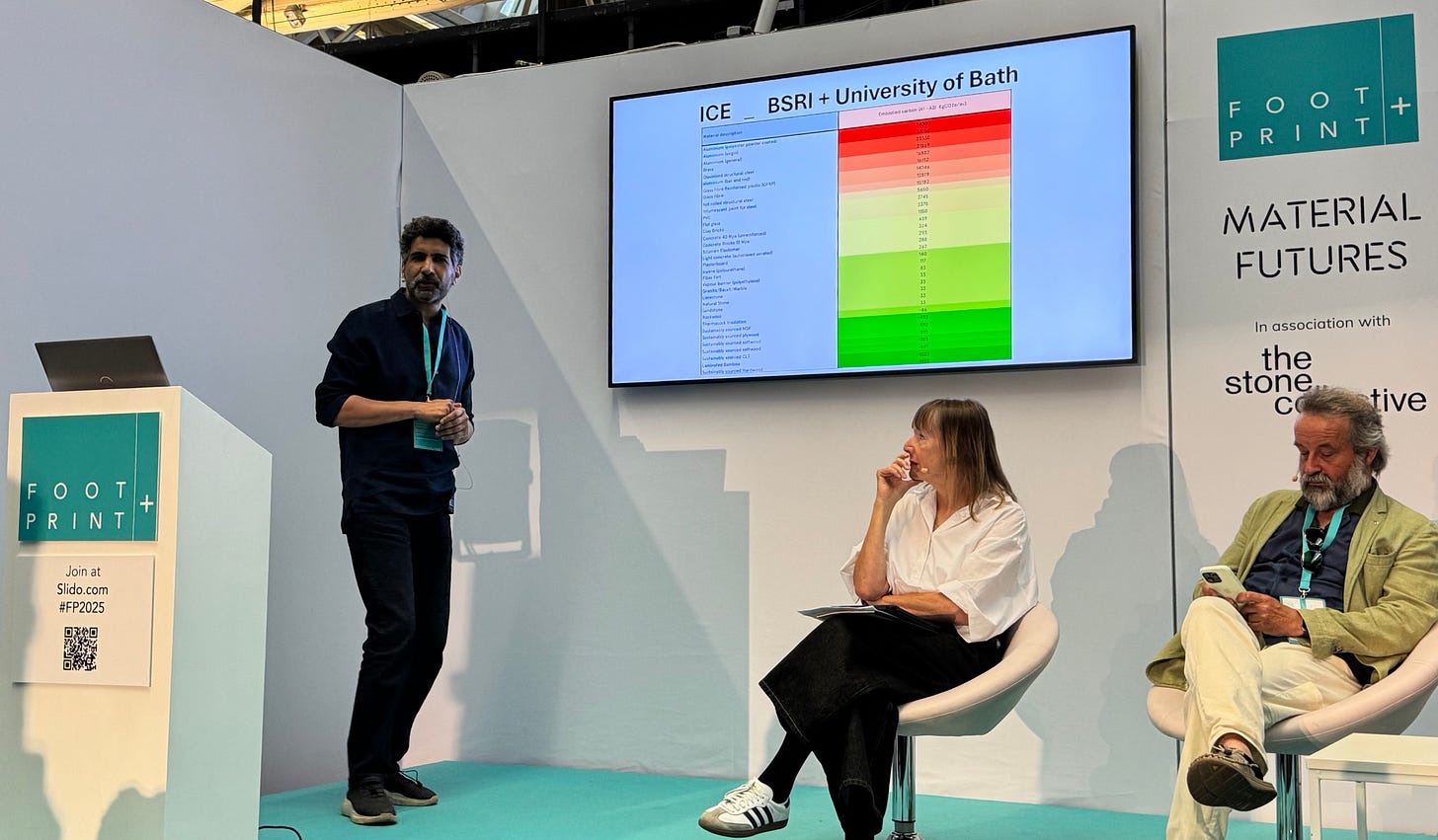Bring on the renaissance in stone building
The age of concrete and steel is over; make way for natural materials like wood and stone.
While visiting the Brough of Birsay in Orkney, my friend and fellow rockhound Jon Linton and I were intrigued by this strange outcrop of whitish rock sitting on top of sandstone and composing most of the face of the island seen from the mainland. We approached it and were shocked to discover it was…. concrete! Designed to look like natural stone, complete with layers, folds, and cantilevers, it is a retaining wall protecting the Norse settlement just behind it from further erosion. (I did not take a decent photo of the full length of it but photographer Coreen Kuhn did here.)
It is the most extreme example that I can think of where we have concrete trying really hard to be stone, when we should really should have just used stone in the first place. I wondered what Pierre Bidaud of The Stone Collective would have thought of it; I was honoured to meet him at the FOOTPRINT+ in London a week earlier.
Pierre Bidaud is one of the prime movers of what the Riba Journal described as a “New Stone Age” of building in the UK. (Another is Steve Webb, who I interviewed last year in London). As he notes in his guide to building in stone,
“Stone has much to offer; it is strong, slow to age, easily maintained, non-combustible, and versatile. Importantly, stone has the ability to greatly reduce the carbon footprint of new buildings. Sometimes referred to as "natural concrete," limestone, granite, and sandstone, if used structurally in solid pieces, are easy to repurpose and require very little energy to reuse.”
“Natural concrete” is a silly retronym. You make concrete by grinding up limestone (calcium carbonate), cooking it at 1450°C to drive off the CO2 and get calcium oxide (quicklime) the main ingredient of cement, which you mix with ground up rock and sand, add water and get…. “artificial stone.” Steve Webb noted, “Not only is it perverse to do this, but the carbon footprint of concrete is 250% higher than stone for a material with only 25% of the strength.”
The artificial stone could be quickly formed into any shape and reinforced with steel, letting architects and engineers do things they couldn’t do in stone. But as I noted in my post about Steve Webb, that’s no longer true; using modern tools like CNC machines and advanced scanning techniques to see inside the stone, you can do amazing things. The Stone Collective writes:
“Emerging from the understanding that stone, with its high compressive strength, behaves like concrete, using cables and rebars for post and pre-tensioning creates endless possibilities, from prefabricated structural beams and columns to optimizing walls and arches.”
Shortly after meeting Bidaud, I did a pilgrimage to 1 Poultry Lane, James Stirling’s Postmodern masterpiece, which is across the street from Norman Foster’s Bloomberg headquarters that I love to hate because back in 2017 it was called “the world’s most sustainable office building” while ignoring the massive upfront carbon emissions of the 600 tonnes of bronze imported from Japan and the quarryful of granite from India. To be fair, just about everyone ignored upfront carbon back then.
Bidaud uses these buildings along with Lutyens’ 1924 building at 27 Poultry in “A short history of the misuse of stone in the 20th century” showing how Lutyens used stone as a self-supporting façade in front of a steel structure, Stirling clipped a veneer to concrete, “a solid concrete shell embellished with a mineral make-up” and Foster fastened stone to concrete, “A tight embrace of two structural materials, leaving a legacy of wasted material and intensive fossil fuel use.” All three architects wanted the character of stone but essentially faked it. “Lutyens, Stirling, and Foster wanted a heart made of stone but built only a skin. However, their desire to use stone proves that architects and clients still want stone buildings as a symbol of authenticity, reassurance, and legacy.”
Bidaud and The Stone Collective call for a return to the use of natural stone as a structural material. They write in “the future of stone”:
“With its short processing time, energy efficiency and frugal use of grey water, quarried stone has the potential to decrease the use of highly polluting artificial solutions. As we strive to lower the construction industry’s carbon footprint, natural stone emerges as a superior choice.”
Really, we are so confused. At the Brough of Birsay, the concrete wants to be stone and fails spectacularly; a nice red sandstone wall would have probably been cheaper than doing this and would have looked a lot better. On Poultry Lane, three of the greatest architects of the twentieth century wanted their buildings to be stone, and ended up with stone wallpaper or “mineral make-up.”
Bidaud, Webb, architect Amin Taha and others like Barrault Pressacco in Paris are using stone as stone, as architects did before the 20th century when steel and concrete took over. They are both wonderful materials, but in a time when we should be worrying about every kilogram of carbon dioxide that is warming our world, we should be looking at the stone below us and the trees around us, we should be embracing natural materials, and welcoming the New Stone Age.
Download The Stone Collective’s wonderful little book at the bottom of the page here, which concludes: “We hope this modest book will lay the foundations for a Renaissance in Stone building.” See also my 2022 Treehugger post: It's Time for a Stone Construction Renaissance.
Special offer!
I felt guilty asking for money whilst traipsing around Scotland, but I am back now and so is my pitch:
I do not want to put up a paywall on this site, but it provides a meaningful portion of my income. So here’s a limited time offer: I will send a signed copy of the print edition of “Living the 1.5 Lifestyle” to anyone in the USA or Canada who signs up for a one-year subscription (C$50, cheap at about US$34.95 )










Quarried stone is usually extremely expensive. I was talking to a guy the other day who wanted to build a stone wall. He was quoted $350 US per cubic foot. Stone is hard to transport and hard to work with. It has negligible R value.
Wood, on the other hand, is relatively inexpensive, easy to work with, easy to transport, stores CO2, and is renewable.
Call it Vegan Concrete and everyone will want some